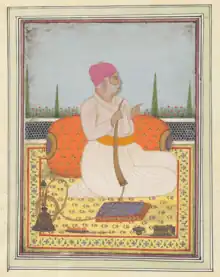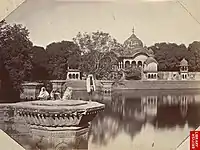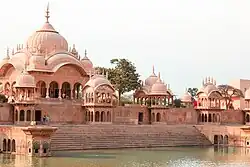Suraj Mal
Suraj Mal (13 February 1707 – 25 December 1763) was a Jat ruler of Bharatpur in present-day state of Rajasthan. Under him, the Jat rule covered the present-day districts of Agra, Aligarh, Bharatpur, Dholpur, Etawa, Hathras, Mainpuri, Mathura, and Rohtak.[3]
| Suraj Mal | |
|---|---|
| Maharaja of Bharatpur | |
 | |
| Maharaja of Bharatpur | |
| Reign | r. 1755 – 1763 AD |
| Coronation | Deeg, 23 May 1755 |
| Predecessor | Badan Singh |
| Successor | Jawahar Singh |
| Born | 13 February 1707 Bharatpur |
| Died | 25 December 1763 (aged 56) near Delhi |
| Wives | Maharani Kishori[1] Rani Gauri[1] |
| Issue | Jawahar Singh Nahar Singh Ratan Singh Nawal Singh Ranjit Singh |
| House | Sinsinwar Jat Dynasty |
| Father | Badan Singh Jat[2] |
| Mother | Maharani Devki |
| Religion | Hinduism |
A contemporary historian had described him as "the Plato of the Jat tribe" and by a modern writer as the "Jat Ulysses", because of his "political sagacity, steady intellect and clear vision."[4] The people, under Suraj Mal, overran the Mughal garrison at Agra.[5] In addition to the troops stationed at his forts, he had an army of more than 75,000 infantry and more than 38,000 cavalry.[5]
Early life
Suraj Mal was born on 13 February 1707, to Badan Singh and Rani Devki into a Hindu Jat family of Sinsinwar clan in Bharatpur, Mughal India (present-day Rajasthan, India). Suraj Mal was the founder of the Kingdom of Bharatpur. The Hindu Kingdom reached its zenith under Suraj Mal.
Establishment of Bharatpur
Suraj Mal conquered the site of Bharatpur from another Jat king Khemkaran Sogaria, the son of Rustam, in 1733 and established Bharatpur town in 1743. He fortified the city by building a massive wall around the city and started living in Bharatpur from 1753.[6]
Lohagarh Fort
.jpg.webp)
Lohagarh Fort was considered an impregnable fort,[7] it was built in the 18th century by Suraj Mal. It remains the only fort in India that was never militarily subdued, even the British failed to capture it despite trying during several attacks under the command of British General Lake. The siege in 1805 lasted for six weeks but the British failed to conquer the fort. Suraj Mal built many other forts and palaces. The fort has three royal palaces inside built between 1730 and 1850.[7]
Suraj Mal | |
|---|---|
| Battles/wars | Battle of Bagru Capture of Aligarh Fort Battle of Ghasera Capture of Delhi Battle of Kumher Capture of Agra Fort |
The attack on the fort by General Lake was done as he wanted to create enmity between Rajput and Marathas so he reminded Ranjit Singh of Bharatpur of the treaty. At that time Holkar was in his protection and the Raja refused to hand him to the British. The British then laid a siege to the fort but were defeated badly. Many of their soldiers and officers were killed. After two days, the British managed to break a section of fort's wall and Suraj Mal attacked them with artillery.
In the third attack, the British successfully crossed the moat but the attack of maharaj filled the moat with the bodies of soldiers. General Lake was asked to secure a peace treaty but he refused, as he reasoned that reinforcement were arriving. The combined forces of Holkar, Amir Khan and Ranjit Singh of Bharatpur then attacked the British.
When the British forces was reinforced from the troops that came from Mumbai and Chennai, they renewed the attack. The British soldiers were attacked by boulders but some of them succeeded to enter the fort, the British however suffered heavy losses. Around 3,000 were killed and several thousand were injured. After this General Lake entered into a peace treaty with the Rajputs.
Jawahar Burj and the Fateh Burj were built to celebrate the victory over the Mughals and the British. The fort is surrounded by deep moats. There is a legend which states that the fort will fall down if a crocodile takes up all the water of the moats. Another legend states that a gate of the fort was brought from Delhi which Alauddin Khilji brought from the fort of Chittorgarh. The gate was brought and fixed in the fort in the 17th century.
Military career
Plunder of old Delhi

The Mughal Emperor had taken back the domain of Awadh and Allahabad from Safdar Jang, wazir of Oudh State, and to avenge his humiliation, Safdar Jang rebelled and attacked Delhi. Suraj Mal also fought under Safdar Jang against the Mughals.[8] On Suraj's advice, Safdar Jang reacted by appointing Akbar Ādilshāh as emperor. On 14 May the supporters of Suraj Mal sacked Chārbāg, Bāg-e-kultāt and Hakīm Munīm Bridge; the next day, Jaisinghpura went on to burn several areas. On 16 May Suraj Mal under Safdar Jang attacked Delhi and defeated Sādil Khan and Raja Devidatta in battle.
Battle of Kumher
Mughal Emperor Alamgir II and his rebellious courtier Siraj ud-Daulah were having a factional feud. Suraj Mal had sided with Siraj. Alamgir sought the help of the Holkar Marathas of Indore. Khanderao Holkar, son of the Maharaja of Indore, Malhar Rao Holkar, laid siege on Suraj Mal's town of Kumher in 1754. While inspecting the troops on an open palanquin in the battle of Kumher, Khanderao was hit and killed by a cannonball from the Bharatpur army. The siege was lifted and a treaty was signed between Suraj Mal and the Marathas, which later proved helpful for Suraj Mal in consolidating his rule.[9][10]
Battle of Bharatpur
The battle of Bharatpur was fought between the army of Bharatpur and the Afghans under Ahmad Shah Durrani on 12 February 1757 when Durrani attacked Bharatpur. Durrani dared not proceed to attack on Deeg, Rajasthan. Suraj Mal's troops fought against him in Ballabgarh, Chaumunha, Gokul, Kumher and in Bharatpur. Suraj Mal's army defeated the Afghan army and Durrani was forced to retreat. During this, he ruined and looted the holy places of Mathura and Vrindavan.
Suraj Mal and Abdali

After his victory over Dattaji on 10 January 1760, Durrani came to Delhi, and called upon Suraj Mal to pay him tribute and join his camp. On such occasions Suraj Mal invariably played a humble role, pleading that he was a petty zamindar. He informed the Shah that he would readily pay his share to the lawful ruler of Delhi at a fixed time. If Durrani stayed in India and assumed sovereignty, he would obey him as his legal master. At the time of the demand he possessed no money as his country had been ruined by the constant movements and pillage of the Marathas and Afghans. It was not in Durrani's nature to tolerate such defiance. He besieged Suraj Mal's fort of Dig on 6 February 1760. Later, he realized that it would require a long time to reduce the strongly fortified, largely garrisoned and heavily provisioned fortress. In such cases he did not make it a matter of prestige. He quietly raised the siege, and marched in pursuit of Malhar Rao Holkar.
Having routed the Maratha chief at Sikandarabad on 4 March 1760, Durrani marched upon Koil (modern Aligarh) which was ruled by Suraj Mal, and he invested the fort of Ramgarh which was commanded by Durjansal. The fort was well-garrisoned and fortified, and large stocks of provisions had been stored therein. The fort could have resisted for long; but the qiladar was disheartened at the occupation of the entire upper Ganga Doab by the Afghans, and to save himself from a massacre, he capitulated in a fortnight or so.[11]
Capture of Agra Fort
-1.jpg.webp)
Suraj Mal decided to capture Agra Fort (which was closeby to the rich town of Agra) to re-establish his influence in Doaba region. On 3 May 1761 the army of Suraj Mal with 4,000 soldiers reached Agra under the command of Balram and gave the message of Suraj Mal to the kiledar (in charge) of Agra Fort that the army wanted to cross the Yamuna and required a place to camp, which the kiledar gave his sanction. Meanwhile, the army entered the fort, but was resisted by the guards, this resulted in 200 lives lost. The army started war from the Jama Masjid. During this period, Suraj Mal stayed at Mathura to observe the situation. On 24 May 1761 Suraj Mal along with Imād and Gangadhar Tantya moved from Mathura, crossed the Yamuna and reached Aligarh. From Aligarh his army moved and captured the areas of the ruler of Koīl and Jalesar. They reached Agra to help his army at Agra in the first week of June. Suraj Mal arrested the family members of the guards staying in Agra town and pressured the guards of the fort to surrender. At last the kiledar agreed to surrender by receiving a bribe of Rs 1 lakh and a jagir of five villages. Thus after a siege of one month, Suraj Mal captured Agra Fort on 12 June 1761.[12]
Death
The Rohilla under Najib-ud-daula had now been encircled which made war inevitable. The Rohilla alongside Sayyidu Muhammad Khan, Afzal Khan and Zaibita Khan had mobilized their troops; though these were smaller in number and had inferior weaponry against Suraj Mal's army. The latter's army was then mobilized and with its superior numbers could have decimated the Rohilla in two days, but an ambush by Sayyidu near the Hindon river took Suraj Mal by surprise. Outnumbered, Suraj Mal attained martyrdom on the night of 25 December 1763. It is manifest that Suraj Mal was slain by a contingent led most probably by Sayyidu.[13][14]
Legacy

His large cenotaph is located in Kusum Sarovar, Govardhan, Uttar Pradesh.[15] His imposing chattri is flanked on either side by two smaller chattris of his two wives, "Hansiya" and "Kishori".[16] These memorial chattris were built by his son and successor Jawahar Singh. The architecture and carving is in the pierced stone style and the ceiling of cenotaphs are adorned with paintings of the life of Krishna and Suraj Mal.[16] His court poet Sūdan recorded his biography in Sujān Charitra.
Notable institutes named after him include Maharaja Surajmal Institute of Technology, Maharaja Surajmal Brij University, Bharatpur and Surajmal Stadium metro station.
In popular culture
- In 2019 Hindi film Panipat, Suraj Mal's character was portrayed by Manoj Bakshi.
- In 1994 Hindi TV series The Great Maratha, Suraj Mal's character was portrayed by Arun Mathur.
See also
References
- Dwivedi, Girish Chandra (1989). The Jats, Their Role in the Mughal Empire. Arnold Publishers. p. 238. ISBN 978-81-7031-150-8.
... (i) Rani Kishori, the daughter of Chowdhari Kashi Ram of Hodal. She was issueless. ... (v) Rani Gauri, she originated from Gori Rajput clan of Amahand and was the mother of Jawahar and Ratan Singh.
- Sarkar, Jadunath (1950). Fall of the Mughal Empire, volume 2. p. 43.
- Chaudhuri, J. N. (1977). "Disruption of the Mughal Empire: The Jats". In Majumdar, R. C. (ed.). The History and Culture of the Indian People. Vol. 8: The Maratha Supremacy. Bharatiya Vidya Bhavan. p. 157. OCLC 1067771105.
During his regime the Jāt State reached its highest extent. Besides the original Bharatpur principality, it embraced the districts of Āgra, Dholpur, Mainpuri, Hathras, Aligarh, Etawa, Mirat, Rohtak, Farrukhnagar, Mewāt, Rewari, Gurgaon, Ghaziabad and Mathurā.
- R.C.Majumdar, H.C.Raychaudhury, Kalikaranjan Datta: An Advanced History of India, fourth edition, 1978, ISBN 0-333-90298-X, Page-535
- Chaudhuri, J. N. (1977). "Disruption of the Mughal Empire: The Jats". In Majumdar, R. C. (ed.). The History and Culture of the Indian People. Vol. 8: The Maratha. Bharatiya Vidya Bhavan. p. 157. OCLC 1067771105. Retrieved 20 December 2019.
- "Maharaja's Palace at Sewar, 3 miles from Bharatpur".
- Thomas, Gavin (2010). The Rough Guide to Rajasthan, Delhi & Agra. Rough Guides. p. 237. ISBN 9781405386883. Retrieved 20 September 2010.
- Hasan, Prof. M. (2002). HISTORY OF ISLAM (2 Vols. Set). Adam Publishers. ISBN 978-8-174-3-50190.
- Advanced Study in the History of Modern India 1707-1813, by Jaswant Lal Mehta, pp606
- Images of Women in Maharashtrian Literature and Religion, edited by Anne Feldhaus, pp185-186
- Gupta, Hari Ram (1961). Marathas And Panipat (in undetermined language).
- Sir Jadunath Sarkar (1966). Fall of the Mughal Empire: 1754-1771 (Panipat). M. C. Sarkar, 1966.
- Journal of Haryana Studies Volume 17. Kurukshetra University. 1985.
- Sir Jadunath Sarkar · (1966). Fall of the Mughal Empire: 1754-1771 (Panipat).
- Cenotaph of Raja Sooruj Mull, Govurdhun. 97140, British Library online collection
- D. Anand, 1992, Krishna: The Living God of Braj, Page 56.
Further reading
- K. Natwar-Singh, Maharaja Suraj Mal, 1707-1763. His Life and Times (George Allen & Unwin, 1981)
- K. Natwar Singh (June 2001). Maharaja Suraj Mal, 1707-1763: His Life and Times. Rupa & Company, 2001. ISBN 9788171675104.
- Dr. Mohan Lal Gupta. Maharaja Surajmal: युग निर्माता महाराजा सूरजमल. Shubhda Prakashan.
- Dr. Prakash Chandra Chandawat (1962). महाराजा सूरजमल और उनका युग. Jaypal Agency Dahtora, Agra.